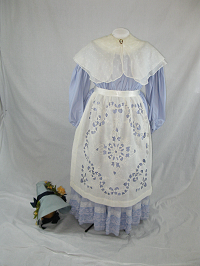1840s
By the 1840s upper and middle class women's existence was becoming more sedentary, they took little outdoor exercise, and in the home gentility forbade active domestic work. Leading the life of a caged canary they were in delicate health. Gowns were worn over heavy underclothes which were made in private by hand. Making these was considered a suitable occupation and they became experts with a needle.
This gown is of blue cotton with lace and a flounce. The unshaped skirt brushes the floor to expose a tiny toe. The waistline has returned to its normal position. The large brimmed bonnet, trimmed with ribbon and flowers, protects from the sun, as does her pelerine (a cape with pointed ends at the center front). The natural waistline has returned and skirts grew to make this waistline look smaller. They were cut of several widths of material unshaped and gauged on to the bodice. To obtain the 5-foot-wide necessary, petticoats became numerous. On Sunday afternoons, maids would go walking with feather dusters stuffed beneath their skirts to obtain the fashionable dimensions. Petticoats ranged from 4 to 6, according to the season. Only the outermost was decorative. Stiff knee length horse hair skirts were worn below the growing number of petticoats to help support the dress.
The little girl style of the 1830s grew into the subdued woman. She put away her bounce, curls, and fluttering ribbons and became more serious and confined. The bonnet closed in around her face and the hem line droops to the floor. Nothing is seen except a tiny toe. Parasols and pelerines sheltered this demure woman of the 1840s. Style called for the low neckline, even for children, but for the modest Victorian woman, it was only exposed for formal occasions such as dinners and balls. Tuckers and pelerines were used to cover the shoulders during the day. A fancy apron of cut work shows off milady's handiwork. Caps of sheer cotton and yards of lace covered the head. Lace frames the face and can be seen when worn under the bonnet. Little jewelry was worn despite the low necklines. Antique gowns of this and later periods have watch pockets sewn into the waist bands. Beginning in the 1840s watches had moved from a chain worn around the neck into a pocket. Although the leg-of-mutton sleeves have collapsed the interest is still at the top of the arm with rows of gathers. Dry goods stores now stocked ready-made garments which required no fitting, such as chemises, petticoats, capes and mantles. Sewed muslin dresses mentioned in newspaper ads were only partly completed. Finished skirts were purchased, with a length of cloth to make the bodice.
Little jewelry was worn despite the low necklines. Antique gowns of this and later periods have watch pockets sewn into the waist bands. Beginning in the 1840s watches had moved from a chain worn around the neck into a pocket. Although the leg-of-mutton sleeves have collapsed the interest is still at the top of the arm with rows of gathers. Dry goods stores now stocked ready-made garments which required no fitting, such as chemises, petticoats, capes and mantles. Sewed muslin dresses mentioned in newspaper ads were only partly completed. Finished skirts were purchased, with a length of cloth to make the bodice.
Click photo for detailed views.


